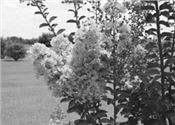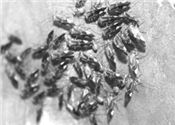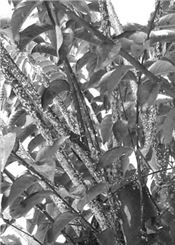Crape Myrtles Can Raise Questions In The Summer
MISSISSIPPI STATE, MISS.
Looking at gardens and landscapes across the South in July, there’s one plant that has most gardeners talking. You may have guessed that I’m referring to the crape myrtle.
Who doesn’t love the large, showy panicles with their many small, individual flowers? I really like when those flower panicles are so heavy that branches are weighed down and drooping. When you add in all the different colors and sizes, there’s a crape myrtle perfect for any landscape space.
One of my favorite crape myrtles is the Infiniti Watermelon. This is a dwarf selection that has been growing in my home landscape for five years, and it is only 18 inches tall.
It seems lately there have been quite a few questions about what’s happening to the crapes. Earlier this year, I wrote about careful and proper crape myrtle pruning. Now, let’s look at some other questions.
Crape myrtle bark scale – or CMBS – is a relatively new, imported insect pest in Mississippi that was first reported in 2004 in Texas.
Now, don’t shoot the messenger, but I found the first reported CMBS in Ocean Springs in 2015. Since then, these pests have been reported across Mississippi.
The first sign you might see is the presence of a lot of scaly, flaking black sooty mold on the tree itself. CMBS exude a sticky “honeydew” that rains down on the branches and any other surface below.
You can treat CMBS with applications of systemic insecticides made to the plant root zone during May and July. For more information on this pest, see Mississippi State University Extension Service Publication 2938, “Crape Myrtle Bark Scale Identification and Control,” at
http://extension.msstate.edu/publications/crape-myrtle-bark-scale-identification-and-control-0 .
Other insects that cause a lot of consternation are bark lice, which can suddenly appear on the trunks of crape myrtles. These pests may look alarming but are actually harmless Bark lice are also called tree cattle, because they appear to move around like a herd. They feed on fungi and algae that grow on the bark surface. And as fast as they appear, they disappear just as quickly.
Other people have asked me about what’s killing their crape myrtles because the bark is starting to peel off. The good news is these crape myrtles are not dying; they simply have what’s called exfoliating bark.
This is a natural process in which the tree sheds its outer layers of bark shed, revealing the beautiful, often cinnamon-colored, inner bark layer.
The bark exfoliation is accentuated in years when we’ve had excessive amounts of rain, as the outer bark expands in response to increased water uptake. It’s no wonder we’re seeing such extreme bark foliation this year with all the rain we’ve experienced.
Because this is a natural process for the crape myrtle, don’t be tempted to help the tree and peel the bark off. You actually can harm the tree by exposing the inner bark before it’s physiologically hardened off.
Keep asking those questions, and be sure to enjoy your garden landscape this summer. ∆

Crape myrtles’ large, showy panicles often hold so many small, individual flowers that they weigh down the branches until they droop.
Photos by MSU Extension/Gary Bachman

The exfoliating bark of crape myrtles adds landscape interest as the outer layers naturally shed, revealing the beautiful, often cinnamon-colored, inner bark.

Bark lice or tree cattle are harmless, but their sudden appearance on crape myrtles can cause some consternation.

Crape myrtle bark scale is a nonnative, invasive pest that shows up as a lot of scaly, flaking black sooty mold on the tree itself.